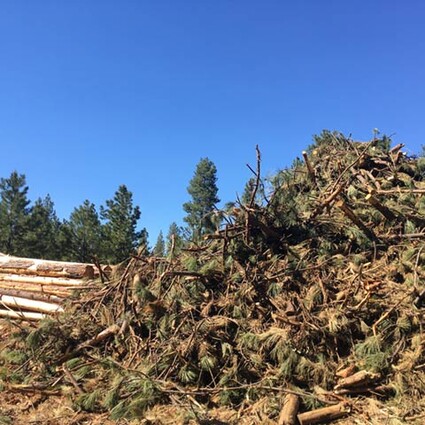Slash burning considered “most economical” for removal
Last updated 12/10/2019 at Noon

TL Brown
A landing pile near Crossroads photographed shortly after logging in May of 2018. It was burned last weekend along with many other slash piles.
With the rise of global temperatures and concern about climate change, the common forestry practice of slash burning is questioned by some citizens and organizations. Slash consists of branches and other debris left behind after a logging or clearing operation.
“The reality is, we live in the woods,” U.S. Forest Service (USFS) Fire Management Officer James Osbourne told The Nugget. “We’re in a fire-adapted ecosystem.”
For millennia, fire burned through what is now Deschutes National Forest in a natural cycle of 3–10 years. Caused by lightning or set by Native Americans, cyclical fires cleared out dead wood and brush. Plant material that might otherwise fuel bigger, hotter fires was not allowed to accumulate.
While a hotter fire often sterilizes soil, a less intense fire can restore soil with nutrients and minerals, boosting microbial life in the forest floor. Fire often clears out invasive weeds, insects, and disease plaguing native trees.
Since European settlement, fire has often been suppressed by people intent on keeping their buildings, trees, and landholdings intact. Prescribed burns today help mimic the old cycle.
“We have different treatment methods,” Sisters District Ranger Ian Reid said of the Forest Service’s contemporary efforts to reduce vegetation.
Selective logging is one method. Private timber companies contract with USFS to harvest trees, creating landing piles of leftover slash. Burning the piles is “most economical,” according to Reid. “It’s a good value to taxpayers.”
“It’s a great tool when it’s implemented properly,” said David Vitelle, owner/operator of Eagle Creek Fire (formerly Bear Mountain Fire).
“In my opinion, in areas that are heavily populated and rely on tourists, known for good air quality and aesthetic location, a person has to be extra-vigilant when they’re burning large amounts of slash material and slash residue,” Vitelle said.
Osbourne noted that burning debris is “not an exact science. We have the underburns in the spring and fall, the broadcast burns… those emit a lot more smoke” than slash piles. In a timber salvage area, “we provide a drying period of time so that we limit the smoldering phase of combustion.”
“I’m not going to say there’s no smoke,” he said, but the active burning of a dry slash pile emits less smoke than the same material would emit if it were green (freshly cut).
Slash-burning pollutants measured by Oregon Department of Forestry in a recent study include carbon monoxide, methane, carbon dioxide, particulate matter of various sizes including under 2.5 mm (PM2.5), black carbon, polyaromatic hydrocarbons (PAHs), polychlorinated dibenzodioxins/dibenzofurans (PCDDs/PCDFs), filter-based metals, and volatile organic compounds.
In Canada, the conservation group Wildsight has come out against the practice.
“Creating a future where logging waste is not burned in piles will reduce health impacts to individuals, reduce carbon emissions and create new opportunities for our communities,” the organization wrote in a statement.
With effort, slash can be used for other purposes. Reid said contracts can be negotiated for that, “if there’s a market.”
Slash can be chipped or ground for hog fuel, which is used in landscaping for mulch, mud control, and to create soft pathways. Some equine facilities prefer it for arenas, so long as black walnut and yew are kept out of the mixture (they can be harmful to horses).
Hog fuel is also used to create biomass fuel, often in the form of pellets. Biomass has been used to power equipment such as boilers and dryers at industrial forestry facilities; pellet stoves are common in Sisters Country homes. Some power plants also run on biomass, creating electricity.
Biomass energy is the subject of controversy. Some consider it an environmentally sustainable, renewable energy source. Others, including Greenpeace, have argued against using biomass on an industrial scale for heating and generating electricity, concluding that the dangers outweigh the potential benefits.
The state of the biomass market determines whether a particular harvesting effort will produce a profit compared to simply burning the debris in place. Government incentives such as tax credits have increased market demand in the past.
Extracting slash from the forest can be costly.
“The reality of making that happen isn’t necessarily super-cost-effective over time,” said Osbourne.
Beyond the immediate economic outcome, converting slash to biomass has environmental impacts. Material must be handled, hauled, and processed, often using equipment and vehicles that use diesel. Greenpeace prefers that the biomass be used locally. Otherwise, it must be shipped to its customer, rarely a carbon-neutral endeavor.
Slash could also be used directly as firewood. However, Osbourne said that if people pick pieces of wood out of slash piles, the piles “don’t burn so well. Where it’s not in a proper pile, it makes more smoke emissions, and makes it harder for the pile to consume.”
All burn piles on USFS land must meet specifications determined by government agencies.
“That spec is all for combustion — to eliminate smoke emissions and have the pile burn completely,” according to Osbourne.











Reader Comments(0)